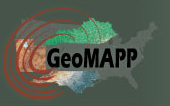May 27, 2010 -- The Geospatial Multistate Archive and Preservation Partnership, one of four projects supported by the National Digital Information Infrastructure and Preservation Program’s Preserving State Government Information initiative, has released an interim report (PDF, 2.01MB) which documents their work from 2007-2009.
 GeoMapp, which is exploring the preservation of digital geospatial data, is comprised of representatives from the geospatial and archives staffs of Kentucky, North Carolina and Utah.
GeoMapp, which is exploring the preservation of digital geospatial data, is comprised of representatives from the geospatial and archives staffs of Kentucky, North Carolina and Utah.
In the initial phase of the project, which ran from November 2007 to December 2009, the three state partners worked together to investigate approaches for preserving and providing enhanced access to superseded and historic geospatial data while engaging geographic data creators and archival professionals at the local, state and federal levels to raise awareness about geoarchiving issues.
Some key observations from the report include:
- Collaboration is a key component to establishing a unified approach to preservation.
- The preservation of geospatial content will only prove valuable to legislators and financial decision makers when they understand that providing sustainable policy and funding support for preservation activities is vital and reaps financial benefits.
- Surveys targeting geographic data producers as well as geographic and archival division leadership help to identify the current state of geospatial preservation within state and local government, and can also act as a vehicle for outreach.
- Creating geospatial-specific records retention schedules helps ensure that data is being managed and preserved appropriately.
- Associating descriptive metadata with the geospatial data, assigning a logical file name to a dataset and being conscious of the data’s format helps to assure future access and use.
- Outreach efforts can be a valuable investment with the side benefit of informing and improving internal practices.
The project has been extended to run through June 2011. The GeoMAPP project will participate in the 2010 ESRI International User Conference (external link) in July.
